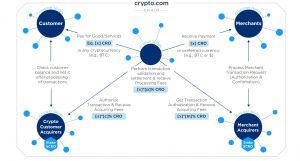Crypto.com Chain and its CRO token function as crypto-based payment solution tasked with supporting cross-asset intermediary currency settlements and improving interoperability between cryptocurrencies and fiat-based payments.

What Is CRO?
Crypto.com Chain is yet another project launched by the Hong Kong-based payment and cryptocurrency platform company Crypto.com (also known as “CRO Protocol Labsâ€). The Chain has its own Crypto.com Chain (CRO) Token which is supposed to allow the users to make cryptocurrency payments to as many globally available merchants as possible. This is to be done by making the CRO an intermediary currency which will allow for the conversion of cryptocurrencies to their fiat counterparts at much reduced cost. By this, the Crypto.com team hopes to combine the token’s global ambition with the adoption support inspired by real-life use cases.
Despite tracing back its history to late 2018, the CRO token and the Crypto.com Chain project have made headlines in early 2019, based on the token’s dramatic price increases which propelled it to the top 50 position on the CoinMarketCap’s ranking (as of April 2019) from the lower top 100 tier it occupied earlier.
What Is Crypto.com Chain Attempting to Do?
Crypto.com Chain is billed as the “next generation†platform which should bring together the merchants and cryptocurrency users on a public blockchain capable of supporting instant, cost-efficient and secure transactions among them. This is to be done by allowing the Chain to tackle some of the issues which are being described as the main snags on the blockchain’s path to a wider adoption:
- Crypto.com Chain is supposed to offer high scalability and fast payment processing. The Chain is designed as the payment network which aims to offer immediate payment confirmations while also supporting scaling in line with an increasing number of transactions. With the help of its decentralized protocol for transaction processing, the target confirmation time on the Crypto.com Chain is set at being less than one second, while the platform promises to support 50,000 transactions per second.
- Crypto.com Chain wants to get rid of the traditional fiat payment structures which are not friendly to innovative payment methods such as cryptocurrencies. The Crypto.com team pulls no punches in describing traditional payment platforms as being resistant to changes, such as the easy introduction of new currencies and removal of strict rules which are imposed on merchants. The problem is exacerbated by having blockchain-powered payment networks which also do not provide for easy integration and streamlined settlement for the cryptocurrencies. In place of this, the Chain will offer systematic integration with supported cryptocurrencies and remove the transaction fees for the merchants. The platform has already introduced its dedicated software development kit (SDK) for the merchants interested in integrating this soluton.
- Crypto.com Chain sees decentralization as the shortcut to making crypto payments a mainstream option. Eventually, the Crypto.com Chain should become a network of a broader range of related cryptocurrency projects. These systems will be customized as alternatives to existing payment systems by being less complex to set up and cheaper to operate. At the same time, they will be offered support going beyond their native blockchain and being more accessible for the use by the newcomers in the crypto industry.
- Crypto.com Chain wants to avoid becoming a potential central point of failure and thus improve its security. Built-in security protocols on the Crypto.com Chain include the use of the trusted execution environments (TEEs) whose main task is the protection of the integrity and confidentiality of data belonging to the participants in this ecosystem. In addition to security, the platform is promoted as offering advanced privacy features thanks to its implementation of the multi-signature Merkelized Abstract Syntax Trees (MAST).
- Finally, Crypto.com Chain will support the expansion of the Crypto.com’s line of MCO Visa payment cards. Considering that the cards in question feature no annual fees and support international purchases with more favorable interbank fees, the Crypto.com team saw their Chain platform as their natural ally in the quest of bringing a larger number of users to the global crypto ecosystem. By offering native support for cryptos and incentives for the participants, the Crypto.com Chain aims to make the targeting of new customers a faster and cheaper process in the world of crypto payments.
Who Are the Participants in the Crypto.Com Chain Ecosystem?
While being open to everyone, Crypto.com Chain has defined roles for various actors seeking to participate in it, with a set of incentives earmarked for each group of participants:
- Customers
- Merchants
- Crypto Customer Acquirers
- Merchant Acquirers
The main role of the customers on the Chain is a straightforward one: they can use the network to make payments in cryptocurrencies. The incentive segment is related to the ability to use discounts in the form of cashbacks funded by the platform whenever they make payment with cryptos. At the same time, the access to cryptocurrencies is provided instantly and the customers can spend them directly from their wallets with a whole range of merchants, both online and offline ones.
The registration process for customers involves several steps:
- The customer sets up or registers an existing crypto wallet or exchange account
- A QR code is shown and scanned at the merchant location by the customer
- The customer needs to confirm payment which needs to be processed
- The customer account is debited while the merchant account gets credited in CRO, bitcoin or fiat currencies depending on their preferences. Customers are covered by Crypto.com BlockShield Buyer Protection Program (B2P2) in case the purchase goes awry. Similarly, after each purchase, the customer will be asked to provide onchain information on whether the purchased goods or services are as described or not.

Merchants on the Crypto.com Chain
The main role of the merchants on the chain is to accept payment in cryptos for the products and services they provide. In exchange for that, settlements in cryptos will come with 0% processing fees, with the option to offer customers the discounts funded by the network.
The requirements for becoming a merchant on the Chain are designed to be flexible in terms of the use of both fiat currencies and cryptos. Merchants can use either their existing point of sale or go for Crypto.com online payment gateway. In addition to this, they can simply integrate provided “Crypto.com Pay†payment button. In any case, merchants instantly receive their payments in CRO or stablecoins.
Crypto.com Chain acts as a bridge between customers and merchants, being in charge of managing the payment flows from customers to merchants, starting from the transaction authorization to its final settlement. The Chain also distributes processing fees to the chain participants and manages dispute resolution procedures.
The Role of Crypto Customer and Merchant Acquirers
Crypto customer acquirers are in charge of acquiring and working with customers and giving them instant access to assets. In addition to facilitating access to the Crypto.com network, the acquirers authorize transactions on the network i.e. the payment requests related to the interaction between customers and a merchant’s POS.
Becoming a customer acquirer on the Crypto.com requires one to:
- Sign a standardized agreement on the processing, settlement and dispute resolution procedures
- Pass compliance evaluation
- Have a minimum amount of CRO locked up
- Integrate the Crypto.com SDK
- Pass user acceptance testing
Similarly, merchant acquirers acquire merchants on the network and send transactions for authorization based on payment requests received from the POS. This covers direct-to-merchant deals, deals with online merchants using the self-service payment gateway and those involving offline merchants who accept credit and debit cards, Alipay or Wechat pay.
Crypto.com Chain Architecture
Since Crypto.com Chain is intended for mobile payments, the architecture enabling them was designed to support several layers tasked with meeting the needs of various types of users:
- Council nodes are in charge of managing transaction validations and settlement operations and reception of processing fees. They order, send, receive and verify transactions as well as provide CRO-based rewards. Council nodes are compensated for their services on a per transaction processed basis. These nodes keep a whitelist log of council, acquirer and settlement agent node identities. In addition to this, the council nodes run a Byzantine Fault Tolerance (BFT) consensus protocol which determines the final order of transaction sequences. The platform’s initial version will implement the Tendermint Core consensus engine.
- Acquirer nodes (including merchant and customer acquirers) manage the settlement on behalf of others, provide an escrow service (i.e. “Proof of Goods & Services Deliveredâ€), verify related transactions and provide services related to verified merchant name mapping. Acquirer nodes are rewarded for their services on a per transaction amount processed basis.
- Settlement agent nodes are tasked with selling CRO tokens for other currencies which are identified as stable, and performing settlement operations for themselves. The goal is to provide the merchants with price stable conversion options after the settlement. Settlement agents can earn a profit by providing conversion services and charging 0.50% rate for fiat payouts to merchants.
- Community nodes allow for direct transactions between customers and merchants and are home to the users who want to check the network’s operations.

CRO Tokens
As a native token of the Crypto.com Chain, CRO tokens are mainly used for intermediary currency settlement across various assets. All participants in the Chain which engage in transactions need to use CRO tokens to pay for the block transaction fees. Tokens are mainly earned as rewards for processing and verifying transactions, with each node being able to stake a fixed amount of CRO tokens in exchange for the right to participate in the network’s operations.
As of April 2019, the market cap for the CRO cryptocurrency stood at USD 304 million. Approximately 4.9 billion tokens were found in circulation, out of the planned supply of 100 billion. The token is available for trading on the crypto exchanges such as Bittrex, HitBTC and others.
History of Crypto.com
As the name of the internet domain, crypto.com was originally registered in 1993 by cryptographer Matt Blaze. Following the cryptocurrency boom which made the domain name a highly desirable asset, Blaze repeatedly refused offers to sell it, at least until the team from the Hong Kong-based Monaco approached him and eventually bought the name from him back in 2018.
The CEO of Crypto.com is Kris Marszalek, a business veteran who also served as the CEO of Ensogo, a social commerce company and the founder of Beecrazy (an e-commerce company). Other members of the company’s C-suite are Rafael Melo (CFO) and Gary Or (CTO).